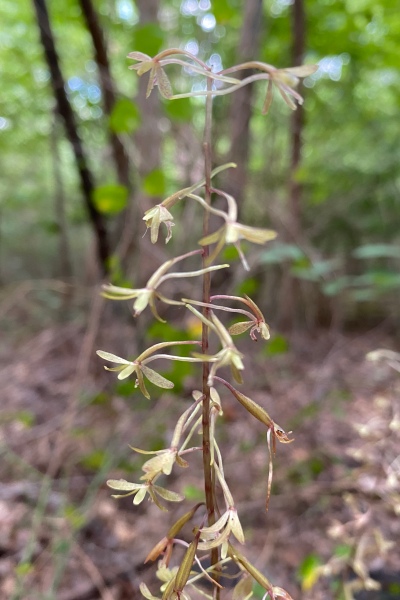
…but craneflies are plants—specifically, orchids, or Tipularia discolor (cranefly orchid).* This past August, the Webster Groves Nature Study Society (WGNSS) Botany Group traveled to the Mississippi Lowlands of southeastern Missouri to look for two species of native orchids, this being one of them. They were not easy to find—even with a location tip, it took a group effort to find them. But persistence paid off, and we found a patch with about 20 individual plants, most in full bloom and a few slightly past.
*One little known “rule” about common names is that the adjective and object (in this case, “crane” being the adjective” and “fly” being the “object”) are separated when the object is true and combined when the object is false or used together as an adjective for another object. Thus, flies in the family Tipulidae are called “crane flies,” because they truly are flies, while orchids of the genus Tipularia are called “cranefly” orchids because they are truly not flies and together form an adjective. Butterfly, dragonfly, and ladybug are examples of straight false objects (thus, for which the common names are compound words), while honey bee, house fly, and assassin bug are further examples of true objects (thus, for which the common names are not compound words).

Everybody who has ever seen this orchid talks about how hard they are to see (despite their relatively tall stature), yet nothing prepares you for just how remarkably difficult they are to see until you encounter them yourself for the first time! I believe this is because of the environment they are in—a dimly-lit forest with dappled light—combined with the lack of contrasting colors on the plants themselves.

This species was not reported from Missouri until 1983, relatively recent, and while for a time it remained known in state only from the southeastern lowlands, it has more recently been reported from several counties across southern Missouri as far northwest as Hickory County. Considering how difficult the plants can be to see, it is tempting to think that this is simply a case of underreporting, but to the contrary the same phenomenon has been observed in Illinois and other states at the edge of its range, leading most botanists to conclude that the species is actually expanding its range. Of course, why this is occurring is anybody’s guess, but it is somewhat satisfying to see at least one native orchid doing well while many others are in decline.

I was extremely fortunate in that I did not end up with a bad case of poison ivy as a result of photographing these plants!

©️ Ted C. MacRae 2021
I have yet to see this species in flower but the plants are fairly distinctive and easy to find although spotty.
They’re a treat to see in flower—maybe place flags next time you see plants and revisit during flowering.
I never realized that about common names! Thank you for for the explanation.